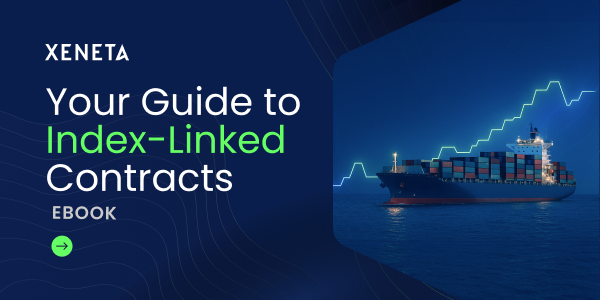More than 500 attendees from 31 countries joined us at the Hyatt Regency Barcelona Tower for the 2025 Xeneta Summit — our annual customer and partner event dedicated to ocean and air freight innovation. From data-driven discussions to bold debates, day one set the tone for what promises to be an unforgettable event.
Read on for our key highlights.
Day One
Setting the scene after a turbulent year
The first day of the Summit was kicked off by Xeneta CEO and Co-Founder, Patrik Berglund. He reflected on the past year, and the huge market volatility that came with it. He also set the tone for the presentations that followed, emphasizing how increasing our understanding and visibility of freight will help us stay equipped for whatever 2026 throws at our industry.

Next, Kim Thornhill, Xeneta Principal for Customer Solutions, and Erik Devetak, Xeneta Chief Technology and Data Officer, took a deeper dive into 2025. By looking at Xeneta’s aggregated freight and supply chain data from the past year, they showed the real-world impact market volatility had on pricing and performance.
As Thornhill observed during the session:
“In 2022 and 2023, many of the large shippers locked into multi-year contracts at a covid peak, stuck paying above average. Small shippers on the other hand remained flexible, riding the market down. By 2024 and more so 2025, the story had flipped”
Looking ahead, Devetak predicts:
"2026 will likely bring more negotiation on transit times, schedule reliability and blank sailings, more diversification of services, and a more diversified portfolio of prices"
Following the 2025 data breakdown, Summit attendees were taken through the macro perspective by experts from BCG-Inverto, McKinsey, and Xeneta. Speakers explored how recent wars, tariffs, geopolitical crises, and disruptions have reshaped supply chains.
As McKinsey noted, “More than 20% of global economic activity today depends on trade.”
It was a powerful reminder of just how interconnected — and fragile — the world’s logistics networks have become. The session gave everyone a shared foundation to build on as deeper discussions unfolded throughout the Summit.
The latest technology and tools helping you navigate market volatility
Fabio Brocca, Xeneta Chief Product Officer, led the much-anticipated product keynote, unveiling new capabilities designed to help shippers make more strategic decisions amid ongoing market uncertainty. As Brocca put it;
“Our industry deserves better. I believe procurement should be faster, more collaborative, and data-driven.”

His message set the tone for what’s next at Xeneta — empowering customers to move beyond reactive decision-making toward more intelligent, connected freight strategies.
Ibrahim Koca, Head of Commercial Trade Management at RHI Magnestia, and Morten Nielsen, Director, Product, Sea Freight at DSV, joined Brocca to shine a spotlight on Xeneta's latest tools and capabilities, including:
- AI Agents to give you automated, actionable recommendations based on what’s happening in your trade lanes
- Integrated Rate Management which gives you a central repository for all your freight rates, charges, and service data — enabling faster decisions, fewer errors, and greater control
- Xeneta Indexing Solution to help you understand, explore, execute, and monitor index-linked contracts — and avoid the pitfalls of rigid 12-month terms
- Carrier Comparison Scorecard to give you a clear, customizable comparison of carriers across the areas that matter to you
- Air Monitor which brings greater visibility, transparency, and understanding of rates between airlines and freight forwarders, and freight forwarders and shippers
To deliver tangible insights into how shippers can use these tools to stay aligned with a changing market, Fernando Pazmino Lombardi, Xeneta Director LSP, and Mads Drejer, Scan Global Logistics, took to the stage for Freight Indexing: Staying in Step with a Changing Market.
This session offered a behind-the-scenes look at Xeneta Indexing — a solution helping BCOs and LSPs build more transparent, trust-based relationships. Through real-world examples of index-linked contracts, attendees saw how this approach reduces time spent on renegotiations and helps manage freight cost volatility more effectively.

Reflecting on a recent conversation with a shipper, Lombardi noted that some feel:
“We’re not in the business of managing freight rates — we’re managing regret.”
Indexing, he explained, helps businesses build on solid ground, not shifting sand — ensuring freight strategies hold steady no matter how fast the market moves.
It’s time to take on the market
After lunch, we welcomed Thomas Cassuto, Chief Commercial Officer, and Cédric Jourdain
Decarbonization & Sustainability Manager, both from CMA CGM, to offer a unique look into how Shippers and Carriers can co-author the future of Green Freight. This prompted questions around nuclear fuel, the viability of e-barges, as well as the role EU regulations, governments and other global carriers will play in the decarbonisation of the industry.

A cross-industry panel of shippers, carriers, and freight forwarders followed, exploring how top performers are using data, digital tools, and well-constructed contingency plans to adapt quickly and respond effectively when disruption hits. The discussion offered sharp insights and practical advice for how organizations can prepare for continuing market volatility — and face it with confidence.
As Renske Schoenmaker, Senior Business Manager Containers Deepsea, Port of Rotterdam, put it:
“We have to also adjust the behaviour otherwise the systems become redundant again”
Her point underscored a central theme of the session: resilience isn’t just about having the right tools — it’s about evolving the way teams think and act when the market shifts.
At this point, we split off into breakout sessions.
In the first, attendees could opt to:
- Hear a real-world example of how data and market intelligence helped an organization navigate disruption, improve supplier relationships, strengthen its supply chain, and stay ahead of volatility.
- Explore the growing importance of using air cargo to their organizations’ advantage and how proactive planning and more transparency in air freight rates and performance can help open up this option.
- Hear a leading freight forwarder’s journey moving from traditional tenders to Xeneta indexing — with practical lessons, benefits, and strategies to follow.
In the second breakout session, attendees could choose to:
- Explore AI in action and see exactly how generative AI can support decision-making, planning, and simulation
- Discover how our Integrated Rate Management System was conceived — and how we turned customer conversations into a tool that addresses their pain points
- Take a deep dive into decarbonization, its challenges, key developments, and future outlooks
One final takeaway came from Sue Shon, Global Procurement Manager, Unilever:
"Competitive. I'm using that word a lot. But as procurement, that is the mantra we should want to live by."

If you’ve made it this far, don’t stop here — explore our Day Two highlights for more perspectives from industry leaders on freight strategy, data, and the future of global logistics.
.png)





